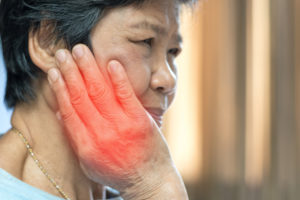The joint that connects your skull to your jaw bone is considered one of the most complex in the human body. It is capable of moving forwards, backwards, and side to side. While you may not think much about this area of your face in your day-to-day life while chewing, talking, or yawning, a change in your temporomandibular joint can cause severe pain and discomfort for those who have to deal with it. In fact, TMD can be the result of certain unwelcome conditions and is associated with numerous symptoms. It affects between 5% and 12% of the population. But just what is TMD? Let’s take a closer look at the causes, symptoms, and treatment for this disorder.
Contents
What is TMD?
TMD, or temporomandibular disorders, are localized in your jaw muscles and their surrounding nerves. Problems can originate in your tissues, bones, or the joint itself and can prevent normal jaw function. There are a few reasons why a person can experience TMD, and some can occur simultaneously. These include:
- Myofascial pain, which is the most common form. You’ll feel soreness or tenderness along your jaw muscles and throughout your neck and shoulders.
- A dislocated jaw. This could be linked to a displaced disk between the jaw bone, also known as the mandible, and the skull area, known as the temporal bone. You may also have an injury to the top, rounded end of your jaw.
- A degenerative joint disease, such as osteoarthritis or rheumatoid arthritis, can also result in TMD.
What are the Causes of TMD?
The causes of TMD can be different for everyone. In some cases, patients may never discover the source of their disorder. However, some predominant causes do exist. For example, bruxism, which is the involuntary grinding and clenching of teeth, can cause TMD. This is because it affects all the central components that affect the disorder, including your muscles, bones, and joints.
Sustaining some kind of trauma or injury to your neck, jaw, or head are other potential causes of TMD. It may also result from joint conditions like arthritis or medical ailments like fibromyalgia and irritable bowel syndrome, which can overlap with TMD symptoms.
What are the Symptoms of TMD?
There are numerous symptoms associated with TMD. The most common is jaw discomfort, especially in the morning or late afternoon. It’s possible to lose range of motion when opening and closing your mouth, potentially having your jaw lock, click, or pop while trying to speak or chew. Within your mouth, your teeth may change the way they fit together, have increased sensitivity, or feel clenched and constantly grinding.
You might suffer from pain spreading behind your eyes and throughout your facial muscles, feeling like a headache. TMD could also cause pain in your shoulders, neck, and back. In some cases, patients experience bouts of dizziness and loss of balance due to tinnitus or ringing in the ears. Earaches are also possible due to the location of bones that affect TMD.
What is the Treatment for TMD?
For some patients, TMD goes away on its own. Others may need to look at treatment options, depending on the severity of their disorder. The good news is that there are a few at-home remedies that seem to work. Over-the-counter pain medications can help relieve pain and swelling. Heating pads can help increase blood flow and relax muscles, while cold packs can reduce inflammation. Finally, a change in diet to softer foods can make all the difference because they require you to chew less.
If you have noticed ongoing symptoms, the best thing you can do for treatment is to seek the help of a medical professional like your dentist. They can recommend tactics to help with the pain and may be able to diagnose the underlying cause. In some cases, your dentist will recommend a mouthguard to reduce your teeth rubbing together, physical therapy, or posture training. Relaxation methods may also be prescribed, as stress increases the risk and severity of TMD.
At Costello Family Dentistry, we aim to provide solutions for our returning and new patients when it comes to their dental care needs. Since TMD can result from bruxism, which affects the teeth, we can help determine a course of action to reduce your pain and discomfort. If you still have questions about what TMD is or are concerned that you may have this disorder, reach out to us.




